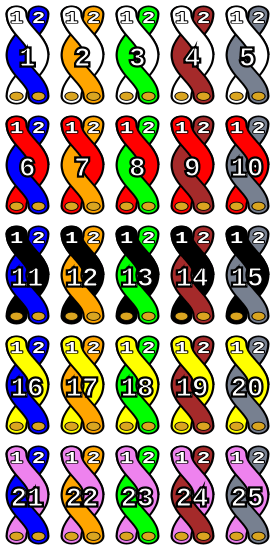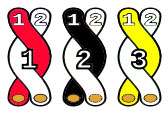25-pair color code


The 25-pair color code is a color code used to identify individual conductors in twisted-pair wiring for telecommunications. The colors are applied to the insulation that covers each conductor. The first (or major) color is chosen from one group of 5 colors and the other (or minor) color from a second group of 5 colors, giving 25 combinations of two colors. The code is often seen in RJ21 cables.
Overview
- The first group of (major) colors is, in order: white, red, black, yellow, violet.
- The second group of (minor) colors is, in order: blue, orange, green, brown, slate.
The 25 combinations are shown to the right in the image. The combinations are also shown in the table below showing the color for each wire and the pair number.[1][2]
| Pair # | First/major color | Second/minor color |
|---|---|---|
| 1 | White (W, Wht) | Blue (BL, Blu) |
| 2 | Orange (O, Org) | |
| 3 | Green (G, Grn) | |
| 4 | Brown (BR, Brn) | |
| 5 | Slate (S, Slt) | |
| 6 | Red (R, Red) | Blue |
| 7 | Orange | |
| 8 | Green | |
| 9 | Brown | |
| 10 | Slate | |
| 11 | Black (BK, Blk) | Blue |
| 12 | Orange | |
| 13 | Green | |
| 14 | Brown | |
| 15 | Slate | |
| 16 | Yellow (Y, Yel, Ylw) | Blue |
| 17 | Orange | |
| 18 | Green | |
| 19 | Brown | |
| 20 | Slate | |
| 21 | Violet (V, Vio, Vol, Pur) | Blue |
| 22 | Orange | |
| 23 | Green | |
| 24 | Brown | |
| 25 | Slate |
In addition to the pair number, the pairs may also be referred to by their color codes as the "major/minor" or "major-minor" pair (e.g. pair #9 is called the "red/brown" or "R-BR" pair).
The first five combinations (i.e. the white group) are very common in telecommunications and data wiring worldwide, but beyond that there is considerably more variation.
The color violet is sometimes called purple, but in the telecommunications and electronics industry it is always referred to as violet. Similarly, slate is a particular shade of gray. The names of most of the colors were taken from the conventional colors of the rainbow or optical spectrum, and in the electronic color code, which uses the same 10 colors (though in a different order).
Usually (unlike the second picture above), each wire in a pair will have a colored stripe, dots, or rings (often called a "tracer") matching the color of its paired wire (as shown in the first picture above). This makes it easy to identify which pair a given wire belongs to, giving each wire in a 25-pair cable its own unique colors. This means that the first pair is a mate of white with a blue tracer and a colour wire of blue with a white tracer. Pair 17 would be a mate of yellow with an orange tracer and a colour wire of orange with a yellow tracer. In cables that do not employ this scheme, to determine which pair a wire belongs to, one has to note which color codes are physically twisted together in the lay of the cable as the sheath is stripped back, since there are multiple wires of each color in the cable (e.g. a 12-pair cable using just the solid color scheme would have 5 white, 5 red, 2 black, 3 blue, 3 orange, 2 green, 2 brown, and 2 slate wires).

When used for common analog telephone service, the first wire is known as "tip" and is connected to the positive side of the direct current (DC) circuit, while the second wire is known as "ring" and is connected to the negative side of the circuit, following the tip and ring convention. Neither of these two wires has any connection to the local ground. This creates a balanced audio circuit with common-mode rejection also known as a differential pair. This convention works in the UK with the first or mate wire as the positive A leg and the colour wire as the negative B leg.
These terms are based on the 1⁄4″ (6.5 mm) TRS phone connectors, which were employed in telephone switchboards in the 19th and 20th centuries, where the "tip" contact of the connector is separated from the "ring" contact by a ring of insulation. The connection furthest from the cable is known as the "tip", the middle connection is the "ring", and the (largest) connection closest to the wire is the "sleeve" (unused in this case).
Larger cables
For cables with over 25 pairs, the first 25 pairs (called a binder group) are marked with mylar ribbons using the colors of the color code starting with a white/blue ribbon, the second binder group with a white/orange ribbon, and so on through the 24th binder group, which has a violet/brown ribbon, and forming a "Super binder" of 600 pairs.[1][2]
In cables of more than 600 pairs, each of the 100-pair binder groups within the 600 pair of 24 binder groups is wrapped with a mylar binder ribbon, or string, matching the "tip" colors of the color code, starting with white. The pattern then starts over with the first 25 pair group as white/blue, and continues indefinitely, in multiples of 600 pairs or parts thereof. For example, a 900-pair cable will have the first 600 pairs in 24 groups of 25 pairs in a white binder, and the remaining 300 pairs in 12 groups of 25 pairs wrapped in a red binder.[1][2]
Some cables are "mirrored" or "clocked" with a pattern that is known throughout the telephone industry. Starting with the first binder group in the center, the technician counts the cable's groups in a spiral direction depending on the location of the Central Office or switch. If looking at the cable's core and the switch is in that direction, you count the groups counter-clockwise. If the cable is the "field side", you count the groups clockwise. There are indicators on the mylar ribbons to know where to begin for each layer and a diagram for the different cable sizes should be readily available for reference.[1][2]
Other color schemes are sometimes used for outdoor cables, particularly outside the U.S., but this color code is common for aerial and underground cables up to several thousand pair in North America. In the UK, the British Post Office (later BT) used this colour code for what is now known loosely as CW1308 spec cables, referring to the Post Office's "Cable and Wire" specification No. 1308.
Extra Pairs / Colors

When working on aerial cable splicing and installation, it is common to use a telephone lineman's set or "Butt Set" to communicate over long distances. To facilitate this, extra pairs of wires are embedded in cables. One extra pair (Red-White) may be embedded into cables that are 6 to 75 pairs; two pairs (Red-White and Black-White) may be encapsulated in cables of 100 to 300 pairs; and three pairs (Red-White, Black-White, and Yellow-White) may be included in cables of 400 to 900 pairs.[2] These extra pairs are often referred to as 'talk pairs', and are never used to deliver dial tone.
Mnemonics
The major group colors can be remembered with the mnemonics:
- For a 100 pair cable (i.e. the first four colors), "Will Rosie Bite You?"
- "Why Run Backwards You Vomit"[3]
- "Winchester Rifles Bring You Victory"
- "We Respect Beautiful Young Virgins"
- A code used by AT&T (and later Lucent Technologies) installers is "Wild Real Blondes Yell Violently"
The minor group colors can be remembered with the mnemonics:
- "BOG BruSh" (This mnemonic is attributed to a British radio engineer, "bog brush" being a colloquial British term for a toilet brush.)
- "Boy On Girl Brings Satisfaction"
- "Bell Operators Give Best Service"
- "Big Old Gorilla Breath Stinks"
- "Big Orangutans Give Brown Shits"
There is also a visual (language independent) mnemonic for the minor group colors. Imagine a sunset landscape top-down:
- The blue sky
- The orange sun
- The green forest
- The brown soil
- The grey bedrock
A mnemonic for both groups is "We Ride Big Yellow Vans Because Old Guys Break Stuff"
or "Women Roast Bright Yellow Vegetables But Old Guys Brown Steaks"
See also
References
- 1 2 3 4 Highhouse, John (1997). A Guide for Telecommunications Cable Splicing. Cengage Learning. ISBN 9780827380660.
- 1 2 3 4 5 "Section G50.607.3 – EVEN PIC Cables" (PDF). Bell System Practices – Outside Plant Construction and Maintenance. American Telephone and Telegraph Company. February 1959. Retrieved September 26, 2013.
- ↑ Abruzzino, James: Communications Cabling (2E), page 187. CNC Press, 2000
| Wikimedia Commons has media related to Color code. |